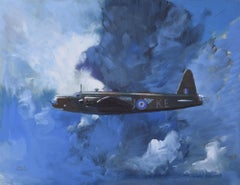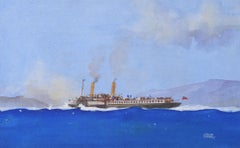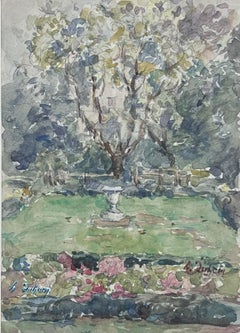Leslie Carr Art
to
4
3
1
4
Overall Height
to
Overall Width
to
3
3
2
2
2
2
1
1
1
1
1
1
1
1
4
1
4
6,910
3,236
2,514
1,217
2
2
2
1
1
Artist: Leslie Carr
Steam Engine Great Northern Railway 1910 drawing by Leslie Carr
By Leslie Carr
Located in London, GB
To see more, scroll down to "More from this Seller" and below it click on "See all from this Seller."
Leslie Carr (1891 - 1969)
1440 Great Northern Railway...
Category
1910s Leslie Carr Art
Materials
Ink, Pen
Paddlesteamer drawing by Leslie Carr
By Leslie Carr
Located in London, GB
To see more, scroll down to "More from this Seller" and below it click on "See all from this Seller."
Leslie Carr (1891 - 1969)
Paddlesteamer
Mixed media with pencil bodycolour
19 ...
Category
20th Century Leslie Carr Art
Materials
Mixed Media, Pencil
Wellington Bomber WW2 gouache painting by Leslie Carr
By Leslie Carr
Located in London, GB
To see more, scroll down to "More from this Seller" and below it click on "See all from this Seller."
Leslie Carr (1891 - 1969)
Wellington Bomber
Gouache
23 x 30 cm
Signed lower r...
Category
20th Century Leslie Carr Art
Materials
Gouache
Paddlesteamer gouache painting by Leslie Carr
By Leslie Carr
Located in London, GB
To see more, scroll down to "More from this Seller" and below it click on "See all from this Seller."
Leslie Carr (1891 - 1969)
Paddlesteamer
Gouache
19 x 29 cm
Signed lower right...
Category
20th Century Leslie Carr Art
Materials
Gouache
Related Items
The Abduction of the Sabine Women , a Renaissance drawing by Biagio Pupini
Located in PARIS, FR
This vigorous drawing has long been attributed to Polidoro da Caravaggio: The Abduction of the Sabine Women is one of the scenes that Polidoro depicted between 1525 and 1527 on the façade of the Milesi Palazzo in Rome. However, the proximity to another drawing inspired by this same façade, kept at the Ecole des Beaux-Arts, and to other drawings inspired by Polidoro kept at the Musée du Louvre, leads us to propose an attribution to Biagio Pupini, a Bolognese artist whose life remains barely known, despite the abundant number of drawings attributed to him.
1. Biagio Pupini, a Bolognese artist in the light of the Roman Renaissance
The early life of Biagio Pupini, an important figure of the first half of the Cinquecento in Bologna - Vasari mentions him several times - is still poorly known. Neither his date of birth (probably around 1490-1495) nor his training are known. He is said to have been a pupil of Francesco Francia (1450 - 1517) and his name appears for the first time in 1511 in a contract with the painter Bagnacavallo (c. 1484 - 1542) for the frescoes of a church in Faenza. He then collaborated with Girolamo da Carpi, at San Michele in Bosco and at the villa of Belriguardo.
He must have gone to Rome for the first time with Bagnacavallo between 1511 and 1519. There he discovered the art of Raphael, with whom he might have worked, and that of Polidoro da Caravaggio. This first visit, and those that followed, were the occasion for an intense study of ancient and modern art, as illustrated by his abundant graphic production.
Polidoro da Caravaggio had a particular influence on the technique adopted by Pupini. Executed on coloured paper, his drawings generally combine pen, brown ink and wash with abundant highlights of white gouache, as in the drawing presented here.
2. The Abduction of the Sabine Women
Our drawing is an adaptation of a fresco painted between 1525 and 1527 by Polidoro da Caravaggio on the façade of the Milesi Palace in Rome. These painted façades were very famous from the moment they were painted and inspired many artists during their stay in Rome. These frescoes are now very deteriorated and difficult to see, as the palace is in a rather narrow street.
The episode of the abduction of the Sabine women (which appears in the centre of the photo above) is a historical theme that goes back to the origins of Rome and is recounted both by Titus Livius (Ab Urbe condita I,13), by Ovid (Fasti III, 199-228) and by Plutarch (II, Romulus 14-19). After killing his twin brother Romus, Romulus populates the city of Rome by opening it up to refugees and brigands and finds himself with an excess of men. Because of their reputation, none of the inhabitants of the neighbouring cities want to give them their daughters in marriage. The Romans then decide to invite their Sabine neighbours to a great feast during which they slaughter the Sabines and kidnap their daughters.
The engraving made by Giovanni Battista Gallestruzzi (1618 - 1677) around 1656-1658 gives us a good understanding of the Polidoro fresco, allowing us to see how Biagio Pupini reworked the scene to extract this dynamic group.
With a remarkable economy of means, Biagio Pupini takes over the left-hand side of the fresco and depicts in a very dense space two main groups, each consisting of a Roman and a Sabine, completed by a group of three soldiers in the background (which seems to differ quite significantly from Polidoro's composition).
The balance of the drawing is based on a very strongly structured composition. The drawing is organised around a median vertical axis, which runs along both the elbow of the kidnapped Sabine on the left and the foot of her captor, and the two main diagonals, reinforced by four secondary diagonals. This diamond-shaped structure creates an extremely dynamic space, in which centripetal movements (the legs of the Sabine on the right, the arm of the soldier on the back at the top right) and centrifugal movements (the arm of the kidnapper on the left and the legs of the Sabine he is carrying away, the arm of the Sabine on the right) oppose each other, giving the drawing the appearance of a whirlpool around a central point of support situated slightly to the left of the navel of the kidnapper on the right.
3. Polidoro da Caravaggio, and the decorations of Roman palaces
Polidoro da Caravaggio was a paradoxical artist who entered Raphael's (1483 - 1520) workshop at a very young age, when he oversaw the Lodges in the Vatican. Most of his Roman work, which was the peak of his career, has disappeared, as he specialised in facade painting, and yet these paintings, which are eminently visible in urban spaces, have influenced generations of artists who copied them abundantly during their visits to Rome.
Polidoro Caldara was born in Caravaggio around 1495-1500 (the birthplace of Michelangelo Merisi, known as Caravaggio, who was born there in 1571), some forty kilometres east of Milan. According to Vasari, he arrived as a mason on the Vatican's construction site and joined Raphael's workshop around 1517 (at the age of eighteen according to Vasari). This integration would have allowed Polidoro to work not only on the frescoes of the Lodges, but also on some of the frescoes of the Chambers, as well as on the flat of Cardinal Bibiena in the Vatican.
After Raphael's death in 1520, Polidoro worked first with Perin del Vaga before joining forces with Maturino of Florence (1490 - 1528), whom he had also known in Raphael's workshop. Together they specialised in the painting of palace façades. They were to produce some forty façades decorated with grisaille paintings imitating antique bas-reliefs.
The Sack of Rome in 1527, during which his friend Maturino was killed, led Polidoro to flee first to Naples (where he had already stayed in 1523), then to Messina. It was while he was preparing his return to the peninsula that he was murdered by one of his assistants, Tonno Calabrese, in 1543.
In his Vite, Vasari celebrated Polidoro as the greatest façade decorator of his time, noting that "there is no flat, palace, garden or villa in Rome that does not contain a work by Polidoro". Polidoro's facade decorations, most of which have disappeared as they were displayed in the open air, constitute the most important lost chapter of Roman art of the Cinquecento. The few surviving drawings of the painter can, however, give an idea of the original appearance of his murals and show that he was an artist of remarkable and highly original genius.
4. The façade of the Milesi Palace
Giovanni Antonio Milesi, who commissioned this palace, located not far from the Tiber, north of Piazza Navona, was a native of the Bergamo area, like Polidoro, with whom he maintained close friendly ties. Executed in the last years before the Sack of Rome, around 1526-1527, the decoration of Palazzo Milesi is considered Polidoro's greatest decorative success.
An engraving by Ernesto Maccari made at the end of the nineteenth century allows us to understand the general balance of this façade, which was still well preserved at the time. The frescoes were not entirely monochrome, but alternated elements in chiaroscuro simulating marble bas-reliefs and those in ochre simulating bronze and gold vases...
Category
16th Century Old Masters Leslie Carr Art
Materials
Ink, Gouache, Pen
Fine Antique French Impressionist Painting View Of A Park with Stone Urn
Located in Cirencester, Gloucestershire
The artist:
Henri Aime Duhem (1860-1941) French *see notes below, signed
Title: The Parkland
Medium:
signed gouache on paper, loosely laid over card, ...
Category
19th Century Impressionist Leslie Carr Art
Materials
Gouache
The 1564 Medici Danti Map of California
By Fra Egnazio Danti
Located in New York, NY
Florentine, Probably Seventeenth Century
Titled
L’ultime parti note nel Indie occidentali
Dated on the edge of the cartouche: “M.D. LXIII. M.AG” [1564…the month of August]
In the 1560s Cosimo I de’Medici, the powerful Duke of Florence, undertook a major renovation of the Palazzo Vecchio, the venerable palace that to this day dominates the city at the Piazza della Signoria. For the Sala della Guardaroba, literally the wardrobe room, but in fact the storeroom of the Duke’s most precious holdings, Cosimo conceived of a grand decorative project that was to reflect in one space the entire cosmos --both an indication of the Duke’s ambition and an allusion to his name. The plan, supervised by Giorgio Vasari, involved the construction of walnut cabinets to contain the Medici treasures, on the outside doors of which were to be placed large hand-painted maps specially commissioned to document and illustrate the current knowledge of the world. Portraits of famous men were to decorate the tops of the cabinets and two large globes –one representing the terrestrial world, the other celestial—were to descend from openings in the ceiling. The commission for the maps, inspired by Ptolemy’s Geographia, was given to the celebrated mathematician and cosmographer, Fra Egnazio Danti (Perugia 1536-1585 Alatri). Fifty-three maps were ultimately created. Thirty were conceived and executed by Danti between 1563 and 1575. The remaining twenty-three were completed by Stefano Bonsignori between 1576 and 1686. They remain in place in Florence in the room for which they were created.
The present work is an exact-size painted, drawn and inscribed copy of Danti’s map of California...
Category
17th Century Old Masters Leslie Carr Art
Materials
Canvas, Pen, Gouache, Watercolor, Ink, Paper
Odalisque
By Jolanta Johnsson
Located in Boxholm, SE
Jolanta Johnsson, experienced Polish artist, graduate of the Academy of Fine Arts in Warsaw, PhD of fine arts, university teacher. She currently lives in Sweden.
This is how she writes about the drawing:
In my intimate drawings, I capture what is closest to me – the private moments that I would hardly want to reveal. And yet, I choose to share them with my audience.
The motif of the odalisque, a reclining woman, has long been a popular subject in art. Throughout history, numerous artists have embraced this theme, and some of their paintings depicting reclining women have become iconic, shaping the course of art in their respective eras. Art historians have extensively written about the influence of these works. Notably, the odalisques created by the French painter Jean-Auguste-Dominique Ingres, such as his renowned piece “La Grande Odalisque...
Category
1990s Contemporary Leslie Carr Art
Materials
Ink, Pen, Acrylic
Inbetweeners
By Jolanta Johnsson
Located in Boxholm, SE
Jolanta Johnsson, experienced Polish artist, graduate of the Academy of Fine Arts in Warsaw, PhD of fine arts, university teacher. She currently lives in Sweden.
This is how she writ...
Category
1990s Leslie Carr Art
Materials
Pen, Acrylic, Ink
Black and White Situation
By Jolanta Johnsson
Located in Boxholm, SE
Jolanta Johnsson, experienced Polish artist, graduate of the Academy of Fine Arts in Warsaw, PhD of fine arts, university teacher. She currently lives in Sweden.
This is how she writ...
Category
1990s Contemporary Leslie Carr Art
Materials
Ink, Acrylic, Pen
Manon (Deuxième Tableau, #7), 1920
By Erté
Located in Greenwich, CT
Erté first met the legendary beauty Ganna Walska in 1920 when she contacted him about creating designs for her nascent opera career. He created many desig...
Category
1920s Art Deco Leslie Carr Art
Materials
Gouache, Paper
Portraits of the Hon. Mary Shuttleworth and Anna Maria, 9th Baroness Forrester
By Daniel Gardner
Located in London, GB
THE HON. MARY SHUTTLEWORTH, NÉE COCKBURN (D. 1777)
and her sister
ANNA MARIA, 9TH BARONESS FORRESTER (D. 1808)
Pastel and gouache on paper laid on canvas, on their original backb...
Category
18th Century Old Masters Leslie Carr Art
Materials
Gouache, Pastel
The Wounded Man by Caleb Althin, Mixed Media on Paper, Signed
By Caleb Althin
Located in Stockholm, SE
Caleb Althin (1866-1919) Sweden
The Wounded Man
Caleb Althin studied at the Academy of Fine Arts in Stockholm 1885–1894 with a few years break for studies abroad in decorative pai...
Category
Early 20th Century Leslie Carr Art
Materials
Watercolor, Mixed Media, Pencil
"Country Haircut"
By Milton Avery
Located in Lambertville, NJ
Jim’s of Lambertville Fine Art Gallery is proud to offer this piece by Milton Avery (1885 – 1965).
Milton Avery was a prominent Modernist painter whose work combined abstraction and...
Category
1940s American Modern Leslie Carr Art
Materials
Watercolor, Gouache, Paper
Place de la Concorde by Jean Dufy - Mixed media on paper, Parisian scene
By Jean Dufy
Located in London, GB
*UK BUYERS WILL PAY AN ADDITIONAL 5% IMPORT DUTY ON TOP OF THE ABOVE PRICE
Place de la Concorde by Jean Dufy (1888-1964)
Gouache and watercolour on paper
48.6 x 63.2 cm (19 ¹/₈ x 24 ⁷/₈ inches)
Signed lower right, Jean Dufy
Executed circa 1955
This work is accompagnied by a certificate of authenticity signed by Jacques Bailly and will be included in the forthcoming Catalogue Raisonné vol.3 currently being prepared by Jacques Bailly.
Provenance: Private collection, France
Artist biography:
Born into a large family in the busy port-city of La Havre in northern France, Jean Dufy was the younger brother of the Fauvist painter Raoul Dufy. In order to please his accountant father, Jean was...
Category
1950s Modern Leslie Carr Art
Materials
Paper, Watercolor, Gouache
Grand Bouquet Et Fruits Devant La Fenêtre À Paris By Marc Chagall
By Marc Chagall
Located in New Orleans, LA
Marc Chagall
1887-1985 Russian
Grand bouquet et fruits devant la fenêtre à Paris
(Large bouquet and fruits in front of the window in Paris)
Stamped with signature “Marc Chagall" (...
Category
20th Century Post-Impressionist Leslie Carr Art
Materials
Paper, Pastel, Gouache
H 55 in W 40.75 in D 3 in
Leslie Carr art for sale on 1stDibs.
Find a wide variety of authentic Leslie Carr art available for sale on 1stDibs.
Artists Similar to Leslie Carr
Robert Sargent Austin, R.A., P.R.E., P.R.W.S.





